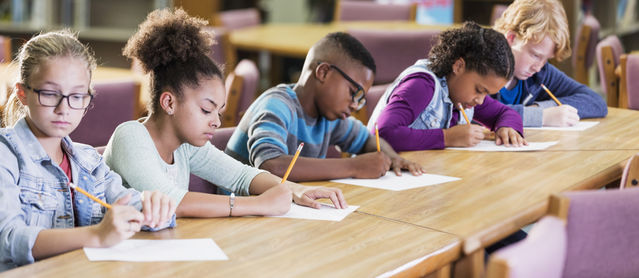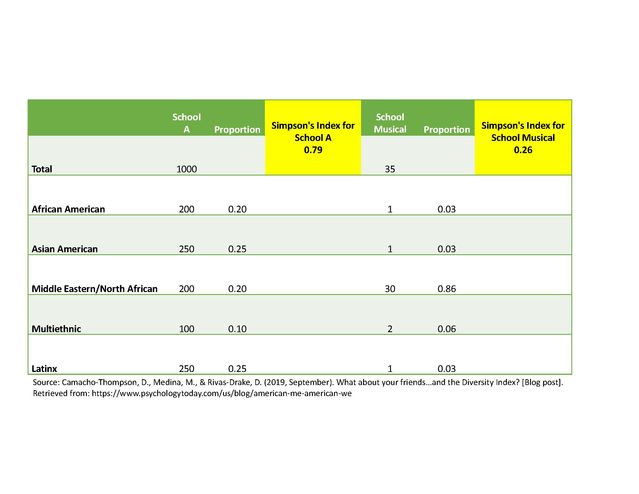
Friends
How Diverse Are Your Friends?
Calculating access to diverse peers.
Posted September 19, 2019

NOTE: This post was co-authored with Daisy Camacho-Thompson and Michael Medina. Daisy is an expert in adolescents’ academic resilience and the engagement of Latinx families into educational systems such as schools, after-school activities, and evidence-based interventions. She is an Assistant Professor of Psychology at California State University, Los Angeles. Michael is an expert in adolescent ethnic-racial identity development across social contexts. He is a doctoral candidate in the Combined Program in Education and Psychology.
---
By the year 2060, it is expected that the United States will become a nation where residents from one ethnic group no longer represent the overall numerical majority. What will this mean for young people?
One concern is that despite growing diversity, youth don’t have opportunities to interact meaningfully with peers of other ethnic and racial backgrounds. This is because, following decades of slow but steady integration, American school districts are more segregated in recent history than they were some years after the landmark Brown vs. Board of Education decision.
As such, more and more students are finding themselves in schools and classrooms whose demographics do not represent the increasingly multicultural demographics of our country, and instead, more closely resemble the segregated classrooms of years past. In the nation’s five largest central city school districts—New York, Los Angeles, Chicago, Miami, and Houston—at least 85% of students are non-White.
But the picture is actually even more complicated than that. There are various disparities in youths’ exposure to diverse peers in school. For example, only 5% of White students are ever a numerical minority (where they represent 24% or less) in their school, whereas 69% of Asian American children are numerical minorities in their school – the percentages are 30% and 22% for African American and Latinx children, respectively.
Why is this Important?
Attending a diverse school is associated with numerous positive outcomes for students. For example, a study by researchers at UCLA measuring diversity in middle schools found that African American, Asian American, Latinx, and White students in schools with more ethnic diversity all felt safer, less, victimized, less lonely, and that their teachers were fair and equitable to all groups.
Academically, researchers such as Tam and Bassett (2004) or Lewis and colleagues (2018) note that students in diverse schools, particularly those of color, tend to earn higher test scores, are more likely to graduate, and are more likely to attend college. Students who are in diverse schools are also more likely to develop positive feelings about members of other ethnic-racial groups and more complex, less stereotypical views of themselves and others. These experiences have been shown to go a long way toward undercutting common racial prejudices and preparing youth to develop more meaningful, multi-dimensional relationships across diverse populations.
What Exactly Does It Mean for a School to Be Diverse?
Numerical diversity is not merely the presence of historically disenfranchised populations. It usually refers to the proportional representation of different groups in one setting. An African American child who attends a school where most of her peers, say 85%, are Latinx, does not attend a “diverse” school. Rather, this child attends a school where most of her peers are historically marginalized or minoritized students.
One mathematical way to assess diversity—Simpson’s Index—captures the likelihood of choosing two people of a different ethnic group at random from a larger group—schools, friends, etc. Although it’s more commonly used to asses “biodiversity,” Simpson’s Index has recently been used in research to calculate diversity in schools, neighborhoods, and friend groups.
One Way to Calculate Diversity
In the example below, School A is relatively diverse, but their school musical is not. There is a 79% chance that if you select two students in School A at random, they will be of different ethnic-racial groups, but only a 26% chance of the same happening if you choose from within their school musical.

To help, we’ve embedded this diversity calculator—give it a try for your school, workplace, team, or group of close friends! Figure out how diverse your group of friends are. In this link, enter the number of ethnic groups into the first categories box. Then, label the groups in the next series of cells, and finally, enter the number of friends for each group.
More than Numbers: Nature and Quality of Exposure Matter, Too
Of course, numerical diversity in schools is critical but not enough. Even within a seemingly integrated school, students may still be placed in comparatively segregated tracking programs or classrooms. The benefits of diversity diminish when classrooms are not diverse, even if their schools are diverse. Therefore, to truly benefit from diversity, schools should provide access to peers in the school, such as in classrooms and organized after-school activities, in order to facilitate the formation of diverse friendships.
Most of our friends tend to be of the same race or ethnicity as ourselves, and young people are no different. Same-group friendships are common in schools, and developmentally typical for a few good reasons. For example, same-group friends help youth learn about their culture and the expectations and values associated with this aspect of their identity. These friendships are also often more comfortable for adolescents and are associated with positive well-being and esteem.
Because such friendships are so common, however, when young people do decide to form cross-group friendships, they are often regarded as especially meaningful. Research by Juvonen and colleagues (2018) bears this out, as cross-group friendships have been linked to improved intergroup relations, self-image, and feelings of security for students of color and White students alike.
As youths’ friend groups become more diverse, they tend to express more positive racial attitudes, correct their misconceptions about other groups, improve their communication and problem-solving skills, and support more positive and multicultural perspectives.
Diverse friendships provide young people with safe and supportive opportunities to critically examine themselves and those around them and develop a cultural awareness that better prepares them for life and relationships in our increasingly complex and diverse world.
References
Goza, F., & Ryabov, I. (2009). Adolescents’ educational outcomes: Racial and ethnic variations in peer network importance. Journal of Youth and Adolescence, 38(9), 1264-1279.
Graham, S. (2011). School racial/ethnic diversity and disparities in mental health and academic outcomes. In Health Disparities in Youth and Families (pp. 73-96). Springer, New York, NY.
Graham, S. (2018). Race/ethnicity and social adjustment of adolescents: How (not if) school diversity matters. Educational Psychologist, 53(2), 64-77.
Juvonen, J., Kogachi, K., & Graham, S. (2018). When and how do students benefit from ethnic diversity in middle school? Child Development, 89(4), 1268-1282.
Kurlaender, M., & Yun, J. T. (2006). Measuring school racial composition and student outcomes in a multiracial society. American Journal of Education, 113(2), 213-242.
Lewis, J. A., Nishina, A., Hall, A. R., Cain, S., Bellmore, A., & Witkow, M. R. (2018). Early adolescents’ peer experiences with ethnic diversity in middle school: Implications for academic outcomes. Journal of Youth and Adolescence, 47(1), 194-206.
Orfield, G., & Lee, C. (2007). Historic reversals, accelerating resegregation, and the need for new integration strategies. A report of the Civil Rights Project/Proyecto Derechos Civiles, UCLA, 1-49.
Rivas-Drake, D., Umaña-Taylor, A., Schaefer, D., & Medina, M. (2017). Ethnic-racial identity and friendships in early adolescence. Child Development, 88(3), 710-724.
Tam, M. Y. S., & Bassett Jr, G. W. (2004). Does diversity matter? Measuring the impact of high school diversity on freshman GPA. Policy Studies Journal, 32(1), 129-143.
U.S. Department of Education, National Center for Education Statistics, Common Core of Data (CCD). (2015-2016) “Public Elementary/Secondary School Universe Survey” in Digest of Education Statistics 2017, table 216.55.



